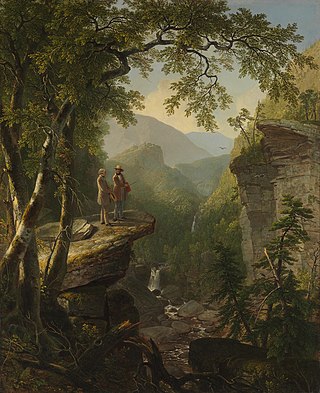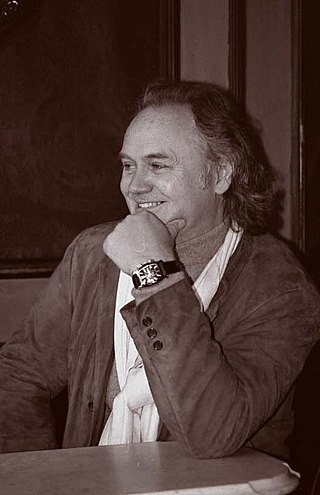
Kay Dian Kriz (born 1945) is professor emerita of art and architecture at Brown University. She is a specialist in British landscape painting and the visual culture of British colonialism and West Indian slavery.

Kay Dian Kriz (born 1945) is professor emerita of art and architecture at Brown University. She is a specialist in British landscape painting and the visual culture of British colonialism and West Indian slavery.
Kay Dian Kriz was born in 1945. She received her BS from Indiana University in 1966, her BA from Western Washington University in 1981 and her MA and PhD from the University of British Columbia in 1984 and 1991 respectively. [1]
Kriz was a member of the faculty of Brown University from where she retired in 2013. [2] She is currently professor emerita of art and architecture at Brown. She is a specialist in British landscape painting and the visual culture of British colonialism and West Indian slavery. [3]
Kriz's first book was The idea of the English landscape painter: Genius as alibi in the early nineteenth century. Writing in Eighteenth-Century Studies , Ann Bermingham described the book as "an illuminating analysis of the place that landscape painting and landscape painters held within the evolving nationalistic discourse of aesthetics in the early nineteenth century" which explained how, "spurred by nationalist sentiments provoked by the Napoleonic wars, the English configuration of artistic "genius" was formulated in opposition to the French school of painting." [4] In a positive review of Kriz's Slavery, sugar, and the culture of refinement (2008), Christer Petley in H-Net praised Kriz for her insights into the visual representations of the West Indies and slavery between the late seventeenth century and the mid-nineteenth century". [5]

Richard Wilson was an influential Welsh landscape painter, who worked in Britain and Italy. With George Lambert he is recognised as a pioneer in British art of landscape for its own sake and was described in the Welsh Academy Encyclopedia of Wales as the "most distinguished painter Wales has ever produced and the first to appreciate the aesthetic possibilities of his country". In December 1768 Wilson became one of the founder-members of the Royal Academy. A catalogue raisonné of the artist's work compiled by Paul Spencer-Longhurst is published by the Paul Mellon Centre for Studies in British Art.

Watercolor or watercolour, also aquarelle, is a painting method in which the paints are made of pigments suspended in a water-based solution. Watercolor refers to both the medium and the resulting artwork. Aquarelles painted with water-soluble colored ink instead of modern water colors are called aquarellum atramento by experts. However, this term has now tended to pass out of use.

Triangular trade or triangle trade is trade between three ports or regions. Triangular trade usually evolves when a region has export commodities that are not required in the region from which its major imports come. It has been used to offset trade imbalances between different regions.

English art is the body of visual arts made in England. England has Europe's earliest and northernmost ice-age cave art. Prehistoric art in England largely corresponds with art made elsewhere in contemporary Britain, but early medieval Anglo-Saxon art saw the development of a distinctly English style, and English art continued thereafter to have a distinct character. English art made after the formation in 1707 of the Kingdom of Great Britain may be regarded in most respects simultaneously as art of the United Kingdom.

Sugar plantations in the Caribbean were a major part of the economy of the islands in the 18th, 19th, and 20th centuries. Most Caribbean islands were covered with sugar cane fields and mills for refining the crop. The main source of labor, until the abolition of chattel slavery, was enslaved Africans. After the abolition of slavery, indentured laborers from India, China, Portugal and other places were brought to the Caribbean to work in the sugar industry. These plantations produced 80 to 90 percent of the sugar consumed in Western Europe, later supplanted by European-grown sugar beet.

Slavery in the British and French Caribbean refers to slavery in the parts of the Caribbean dominated by France or the British Empire.

Kindred Spirits (1849) is a painting by Asher Brown Durand, a member of the Hudson River School of painters. It depicts the painter Thomas Cole, who had died in 1848, and his friend, the poet William Cullen Bryant, in the Catskill Mountains. The landscape painting, which combines geographical features in Kaaterskill Clove and a minuscule depiction of Kaaterskill Falls, is not a literal depiction of American geography. Rather, it is an idealized memory of Cole's discovery of the region more than twenty years prior, his friendship with Bryant, and his ideas about American nature.

The term British West Indies refers to the former English and British colonies and the present-day overseas territories of the United Kingdom in the Caribbean.

John Charles Barrell FBA FEA is a British scholar of eighteenth and early nineteenth century studies.
Chinese Caribbeans are people who are predominantly of Han Chinese ethnic origin living in the Caribbean. There are small but significant populations of Chinese and their descendants in all countries of the Greater Antilles. They are all part of the large Chinese diaspora known as Overseas Chinese.

Roy Petley is a British painter.

Agostino Brunias was an Italian painter who was primarily active in the West Indies. Born in Rome around 1730, Brunias spent his early career as a painter after graduating from the Accademia di San Luca. After he befriended prominent Scottish architect Robert Adam and accompanied him back to Britain, Brunias left for the British West Indies to continue his career in painting under the tutelage of Sir William Young. Although he was primarily commissioned to paint the various planter families and their plantations in the West Indies, he also painted several scenes featuring free people of colour and cultural life in the West Indies. Brunias spent most of his West Indian career on the island of Dominica, where he would die in 1796. Historians have made disparate assessments of Brunias's works; some praised his subversive depiction of West Indian culture, while others claimed it romanticised the harshness of plantation life. Haitian revolutionary Toussaint Louverture was a prominent admirer of his work.

The Crown Colony of Jamaica and Dependencies was a British colony from 1655, when it was captured by the English Protectorate from the Spanish Empire. Jamaica became a British colony from 1707 and a Crown colony in 1866. The Colony was primarily used for sugarcane production, and experienced many slave rebellions over the course of British rule. Jamaica was granted independence in 1962.

Landscape painting in Scotland includes all forms of painting of landscapes in Scotland since its origins in the sixteenth century to the present day. The earliest examples of Scottish landscape painting are in the tradition of Scottish house decoration that arose in the sixteenth century. Often said to be the earliest surviving painted landscape created in Scotland is a depiction by the Flemish artist Alexander Keirincx undertaken for Charles I.

Christiana Joan Elizabeth Ruth Payne is a British art historian at Oxford Brookes University who is a specialist in genre painting and the depiction of the natural environment in British art of the eighteenth and nineteenth centuries.
Andrew Frank Hemingway is professor emeritus of art history, University College London. He is a specialist in British landscape painting of the nineteenth century, which he interprets through a Marxist lens, and the historiography of Marxist art history.
Ann Cathleen Bermingham is an American art historian and educator. A specialist on eighteenth- and nineteenth-century British art, Bermingham is Professor of Art History Emeritus at the University of California, Santa Barbara.
The Sugar Cane was a pioneering georgic poem adapted to a West Indian theme, first published in 1764. With renewed interest in Caribbean literature, and especially after a new edition was published in 2000, it has attracted critical attention, especially its author's attitude towards slavery.

Thomas Gainsborough was the first British artist to employ cottages as a major subject, in what has become known as his "Cottage Door" paintings, painted during the final decades of his life; and was in the vanguard of a late 18th century fad of interest in them.